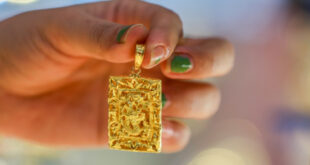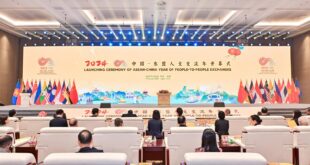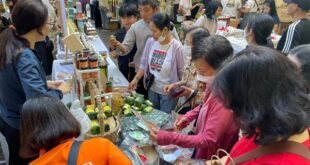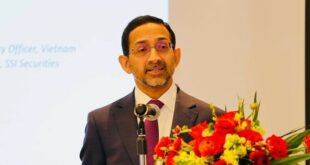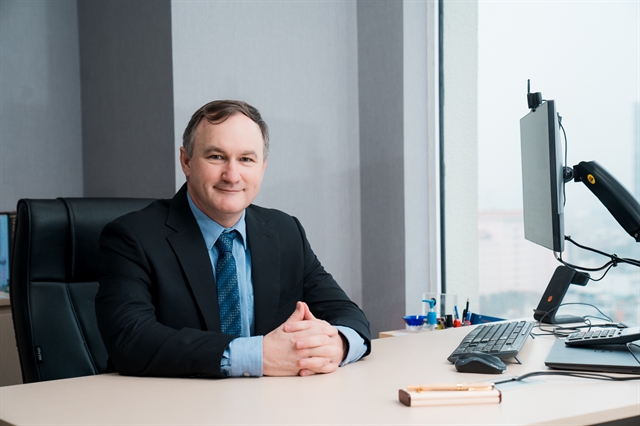
MHT at forefront of global megatrends
Craig Bradshaw, CEO of Masan High-Tech Materials Corporation (MHT), shared the company’s vision to become a leading integrated supplier of advanced high-tech materials critical to global innovation, and his thoughts on being the operator of the firm with the biggest tungsten deposits, at Núi Pháo Mining in Thái Nguyên, northern Việt Nam.
In the most severe time of COVID last year, MHT saw its most successful business year in its history, with tungsten output and recycling rates both reaching record highs. What is the secret to this success, and can you tell us about the Núi Pháo Mine?
When we first came in 2011, Núi Pháo appeared to be paddy fields and buffalos. Over three years, we brought in the construction director and built a team of people to take it from an idea or a concept to a commercial operation.
At the time we did that, that was the first new tungsten mine to be brought into development outside the Western world in 15 years. And so, it’s a polymetallic deposit, tungsten, fluorspar, copper, bismuth and then a bit of gold. So, it had its complexities.
When listed around 2014 as Masan Resources, we went into a joint venture with H.C Starck to build an APT plant in Việt Nam. So, then we were able to process their tungsten concentrates into Ammonium ParaTungstate (APT). And then, in 2020, we ended up taking over the whole of H.C Starck’s global tungsten powder business and changed the company name to Masan High-Tech Materials. And that then took us further downstream into tungsten carbide, tungsten metal powders, and tungsten chemicals for various industries. So, at the time, we went from globally 30 customers to globally 350 plus customers.
Masan High-Tech Materials will celebrate its 12th birthday this year, and H.C. Starck Tungsten Powders is celebrating its 102nd birthday. You know, a company that’s been around for 10 years is taking over a company that has been around for over 100 years. A variety of cultural issues were created from that, aside from nationality. Plenty of things needed to be done. Nevertheless, businesses worked well, and we’ve continued to grow the business. We’ve built market share and are developing plans to extend the business beyond the tungsten, fluorspar and bismuth, copper and cobalt that we do today and into other materials.
Our result last year is a combination of factors. When we set strategies, we had all of our leaders come together for two days to talk about what will happen over the next five to 10 years and how we ensure that we’re going to have a winning formula to stay relevant.
Our success in 2021 resulted not from what we did in 2021 but from what we have been doing over the past three or four years. It’s an outcome of the hard work and efforts of the 2,000+ staff members dedicated to delivering our vision of ensuring our focus on innovation and our customers’ happiness. I think as long as we continue to do that, we will be successful.
Could you share more details about the recycling technology platform owned by MHT and member companies?
Through the acquisition of H.C. Starck, a leading recycler of tungsten, cobalt line, molybdenum line, tantalum line and other materials, we started to re-look at utilising and reinvigorating those production lines.
And interestingly, as a result of marrying up a mining and mineral processing company with an industrial products processing company, the combination of getting all the smart people in a room together has given us some new technology ideas we’ve applied for new patents in the back end of last year.
They are now working through a pilot plant, but we’re developing a pilot plant to recover lithium, nickel, copper, cobalt, and manganese from black mass, for example. We didn’t start out looking at black mass; what we started looking at was sludges from hard tool recycling after having taken out the tungsten and the cobalt.
There were other materials left, and we looked at how we could get the full value from those sludges. It just so happens that in the process of doing that, we decided to test the same techniques or processes on black mass and found that it works equally well.
And that technology still got to go through all the proof of concept, but if it works, it recycles those materials with a lower environmental footprint than the currently available technology, so it uses less energy and less water to recycle those materials.
What is the company’s philosophy of sustainability in mining production, and how do you prepare to meet the sustainable targets?
Masan Group Chairman’s view of the world is that if you are not positioning yourself for sustainability and actively participating to ensure that you are sustainable, your organisation won’t survive.
It’s certainly something we’ve adopted within MHT and to the point where we’re no longer thinking about sustainability as a cost to the business. We’re looking at sustainability as an efficiency. We reuse 78 per cent of our water at the Núi Pháo mine operations, and the more water we can reuse, the lower our cost of water consumption. On the other hand, it protects the local environment and is efficient for us.
Sustainability is also being open-minded to what we learn from industrial partners. We don’t have a monopoly on good ideas. If the BHP, Rio, Samsung, and Tesla are doing smart stuff, they publish it. We are positioning ourselves to participate in the global shift towards sustainability. We’re looking at urban mining and how we can ensure that it meets with recycling urban waste, manufacturing waste, industrial waste, and how we can work on reprocessing tails.
As one of the country’s largest material providers, how has MHT contributed to Việt Nam’s sustainability journey?
We are confident that MHT already went down the sustainability path before the Prime Minister announced that Việt Nam would embark on a net-zero emissions journey.
Today, we recycle around 83 per cent of the water used in our processes in Việt Nam, and approximately 26 per cent of our global tungsten production comes from recycling tungsten scraps. We aspire to be a global leader in every aspect. Over the past few years, we have had a look at what other countries are doing and applied cutting-edge technology to our business in Việt Nam. Furthermore, we have learned precious knowledge from our colleagues over in Germany, who have been applying sustainability and energy reduction measures for more than 20 years.
Our Việt Nam team here seeks to be the gold standard in sustainability and work with global companies to implement best-in-class practices, so we are not simply a follower but a leader.
Moreover, we are among a few groups in Việt Nam that include our sustainability report in our annual report. I’m proud to say that our report is another considerable milestone illustrating our concerted commitment to responsibility, transparency, and sustainability.
The economic recovery fund in Núi Pháo Mine could be an example of our ESG, in which we invest in micro-finance projects to support local businesses as well as provide free trainings for the local people. There’s an example of an informal economy that borrowed money from the economic recovery fund and then turned it into a successful business. The closest example is the story of Anh Duong package company, which makes the bag for our products. They now no longer make bags just for us, but can export bags to the US, Korea and other countries.
We have different canteens that are set up on-site and are run by local people, and we give our employees an allowance for lunch so that they can spend that money themselves with different canteens. So, there are different opportunities that that exist all around.
ESG is about who we want to be, the people we work with, suppliers and customers, and to be a company that people want to work for. I want people to be proud of being part of the Masan family and being proud of that when they go out with their friends.
Buying a company with more than a hundred-year history like H.C. Starck, what does the future look like for the products that MHT produces?
The future looks good. For a range of reasons, when you look at the global megatrends, you look at the urbanisation that requires investment, roads, rails, electrification, and buildings so as urbanisation continues, that’s good for our products that go into industrial application.
Renewables like solar, wind and electronic vehicles that consume tungsten, copper and, in some cases, fluorspar for going into cooling systems are good for our business.
As we’ve been working with different battery manufacturers looking to try and get better performance out of batteries, we’re seeing the significant market potential for our tungsten-based products to go into the electrolyte side or on the anode and cathode side of the batteries. As different partners are testing various solutions, we’re now more confident in the automotive consumption of tungsten than we were about two or three years ago.
This year is looking good. We’re getting our people together. We’re getting our people across different parts of the business, and we have brought many different people together for the first time in the last month, and we already see the benefits of that.
I think that there’s nothing better than getting really smart people together in a room, giving them a framework or an issue, or an opportunity as we call it, and seeing what they’re capable of, and that’s what I think we’ll get more value out of this year and next couple of years, bringing our people together and getting them to collaborate more. — VNS
- Reduce Hair Loss with PURA D’OR Gold Label Shampoo
- Castor Oil Has Made a “Huge” Difference With Hair and Brow Growth
- Excessive hair loss in men: Signs of illness that cannot be subjective
- Dịch Vụ SEO Website ở Los Angeles, CA: đưa trang web doanh nghiệp bạn lên top Google
- Nails Salon Sierra Madre
 VnExpress News The News Gateway of Vietnam
VnExpress News The News Gateway of Vietnam
